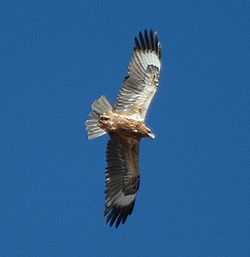Black-breasted Buzzard
| Black-breasted Buzzard | |
|---|---|
 | |
| Conservation status | |
| Scientific classification | |
| Kingdom: | Animalia |
| Phylum: | Chordata |
| Class: | Aves |
| Order: | Falconiformes (or Accipitriformes, q.v.) |
| Family: | Accipitridae |
| Genus: | Hamirostra Brown, 1845 |
| Species: | H. melanosternon |
| Binomial name | |
| Hamirostra melanosternon (Gould, 1841) | |
The Black-breasted Buzzard (Hamirostra melanosternon) or Black-breasted Kite, is a large bird of prey in the family Accipitridae and the monotypic genus Hamirostra. It is sometimes known as the Black-breasted Kite, but is neither a kite nor a buzzard, rather a kind of eagle.
Description
The Black-breasted Buzzard is a large bird of prey, intermediate in size between the Little Eagle and the Wedge-tailed Eagle. It is 50–60 cm (20–24 in) in length and has a wingspan of 145–155 cm (57–61 in). Females are larger than the males, and weigh more, with males weighing around 1.2 kg (2.6 lb) and females weighing 1.4 kg (3.1 lb). Adult birds are relatively easy to recognise by their mainly dark plumage combined with distinctive white patches on the wings at the bases of the primary feathers.
Distribution and habitat
Native to Australia, the Black-Breasted Buzzard is found mainly in the northern and central parts of the continent, living in the deserts, dry grasslands, shrublands, sparse tropical woodlands and tree-lined watercourses. It does not occur in Tasmania.
Feeding
Black-Breasted Buzzards eat rabbits, large lizards, other birds and carrion. It will also raid the nests of ground-nesting birds, breaking large eggs by hurling stones against them with its large beak and then eating the contents. (see gallery below).

Breeding
This species nests in trees, often along watercourses, building a platform of sticks with a central leaf-lined depression for the clutch of usually two eggs. The incubation period is about 40 days, with chicks fledging about 60 days after hatching.
References
- ↑ BirdLife International (2012). "Hamirostra melanosternon". IUCN Red List of Threatened Species. Version 2013.2. International Union for Conservation of Nature. Retrieved 26 November 2013.
- BirdLife International. (2006). Species factsheet: Hamirostra melanosternon. Downloaded from http://www.birdlife.org on 3/12/2006
- Marchant, S.; & Higgins, P.J. (Eds). Handbook of Australian, New Zealand and Antarctic Birds. Vol. 2: Raptors to Lapwings. Oxford University Press: Melbourne. ISBN 0-19-553069-1
-

-

Hurling stone to break into emu egg. Stage one
-

Stage two. Egg has been smashed open
| Wikimedia Commons has media related to Hamirostra melanosternon. |
| Wikispecies has information related to: Hamirostra melanosternon |
